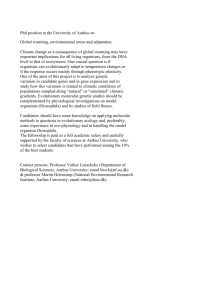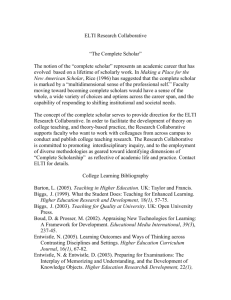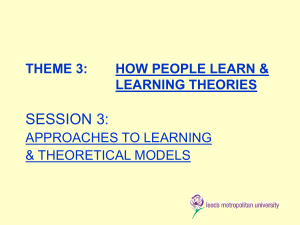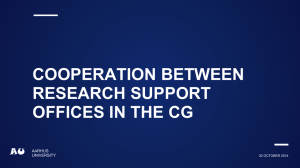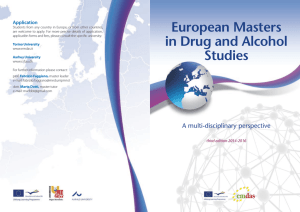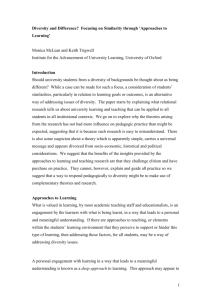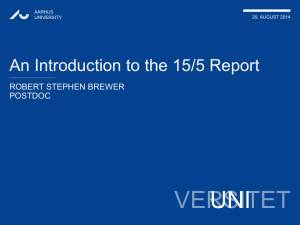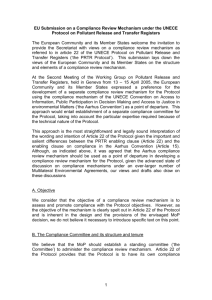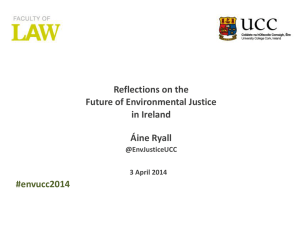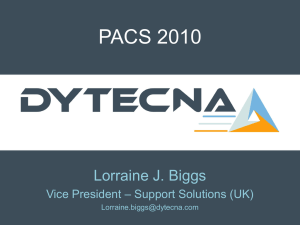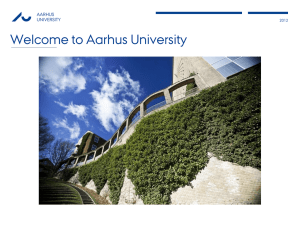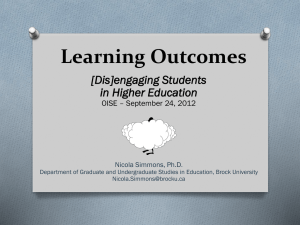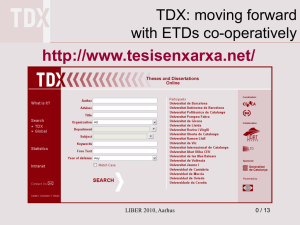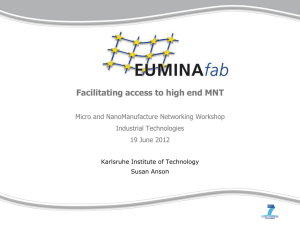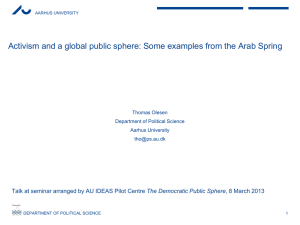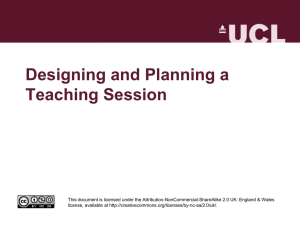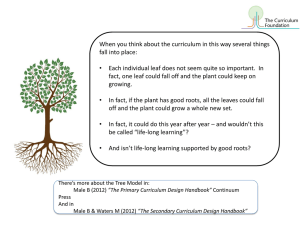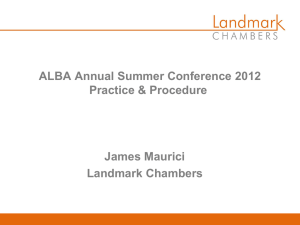Active Learning in HE. Concepts and research
advertisement
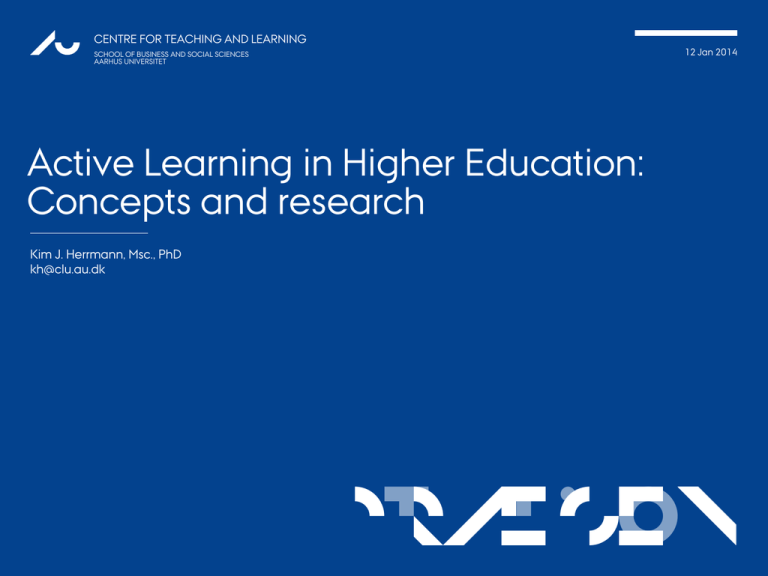
CENTRE FOR TEACHING AND LEARNING 12 Jan 2014 SCHOOL OF BUSINESS AND SOCIAL SCIENCES AARHUS UNIVERSITET Active Learning in Higher Education: Concepts and research Kim J. Herrmann, Msc., PhD kh@clu.au.dk pRÆSEN TATION CENTRE FOR TEACHING AND LEARNING School of Business and Social Sciences Aarhus University Active Learning: Theory and Research 12 Jan 2014 What is active learning? Cognitive activity (Biggs 2012, Mayer 2004) vs. behavioral activity Two major components (Entwistle 2009): 1. ”How much”: Organized effort 2. ”How”: learning strategies deep and surface approaches to learning Learning strategies are not stable can be influenced by carefully designed learning environments (e.g teaching methods or assessment) (Eley 1992, Prosser & Trigwell 1999) 2 CENTRE FOR TEACHING AND LEARNING School of Business and Social Sciences Aarhus University Active Learning: Theory and Research 12 Jan 2014 Biggs (2012:40) 3 CENTRE FOR TEACHING AND LEARNING School of Business and Social Sciences Aarhus University Active Learning: Theory and Research 12 Jan 2014 Research on active learning strategies › Overall, the empirical evidence supports that deep approaches and organized effort improves academic performance (Marton & Säljö 2005, Enwistle 2009, Biggs &Tang 2011). › Recent meta-analysis (Richardson et al. 2012) › Y=academic performance (GPA) › r+deep= 0.14*, N(k)=5,211(23) › r+surface=-0.18*, N(k)=4,838(22) › r+effort= 0.32*, N(k)=8,862(19) 4 CENTRE FOR TEACHING AND LEARNING School of Business and Social Sciences Aarhus University Active Learning: Theory and Research 12 Jan 2014 Research on teaching for active learning › Teachers’ focus: University teachers who focus on the students learning activities (rather than how best to cover the syllabus themselves) are more likely to have students applying deep approaches to learning (Trigwell, Prosser & Waterhouse 1999) › Interactive engagement: Positiv correlation between degree of interactivity in lectures (i.e. clickers) and degree of conceptual understanding have been found (Hake 1999). › Students’ perspective: Students have different preferences for ”good” teaching (Parpala et al. 2011) and they perceive the context differently (Prosser & Trigwell 1999) › some sceptisism should be anticipated (Kember et al. 2003, 2004) 5 CENTRE FOR TEACHING AND LEARNING School of Business and Social Sciences Aarhus University Active Learning: Theory and Research 12 Jan 2014 Conclusion and implications › Teaching requiring student activity is more likely to promote deep approaches to learning and organised effort ( academic performance) › However, no ‘one-size-fits-all’ (Hattie 2009) and sometimes student-centred teaching meets sceptisism (Baeten et al. 2012) Teaching for active learning is more likely to succeed when students find the activities meaningful and worthwhile › Clear instructions › Teaching methods <=> intend learning outcomes (”læringsmål”) › Teaching methods <=> assessment critieria (mode of examination) › Introduced early in the bachelor programme › Active learning appreciated within the department 6 CENTRE FOR TEACHING AND LEARNING School of Business and Social Sciences Aarhus University Active Learning: Theory and Research 12 Jan 2014 References › Baeten, M., Kyndt, E., Struyven, K., & Dochy, F. (2010). Using student-centred learning environments to stimulate deep approaches to learning: Factors encouraging or discouraging their effectiveness. Educational Research Review, 5, 243-260. › Biggs, J. (2012). What the Student Does: Teaching for Enhanced Learning. Higher Education Research and Development, 31, 39-55. › Biggs, J. & Tang, C. (2011). Teaching for Quality Learning at University: What the Student does. (4 ed.) Open University Press. › Entwistle, N. (2009). Teaching for Understanding at University: Deep Approaches and Distinctive Ways of Thinking (Universities Into the 21st Century). (1 ed.) Palgrave Macmillan. › Entwistle, N. & Tait, H. (1990). Approaches to learning, evaluations of teaching, and preferences for contrasting academic environments. Higher Education, 19, 169-194. › Hake, R. R. (1998). Interactive-engagement versus traditional methods: A six-thousand-student survey of mechanics test data for introductory physics courses. Am.J.Phys., 66, 64-74. › Hattie, J. (2009). Visible learning: a synthesis of over 800 meta-analyses relating to achievement. (1 ed.) Routledge. › Hattie, J. (2012). Visible learning for teachers: Maximizing impact on learning. (1 ed.) (vols. 1) London and New York: Routledge. › Kember, D., Jenkins, W., & Ng, K. C. (2003). Adult Students' Perceptions of Good Teaching as a Function of Their Conceptions of Leanring--Part 1. Influencing the Development of Self-Determination. Studies in Continuing Education, 25, 239-251. 7 CENTRE FOR TEACHING AND LEARNING School of Business and Social Sciences Aarhus University Active Learning: Theory and Research 12 Jan 2014 References › Kember, D., Jenkins, W., & Ng, K. C. (2004). Adult Students' Perceptions of Good Teaching as a Function of Their Conceptions of Learning--Part 2. Implications for the Evaluation of Teaching. Studies in Continuing Education, 26, 81-97. › Marton, F., Hounsell, D., & Entwistle, N. (2005). The Experience of Learning: Implications for teaching and studying in higher education. Edinburgh: Edinburgh: University of Edinburgh, Centre for Teaching, Learning and Assessment. › Marton, F. & Säljö, R. (1976). On Qualitative Differences in Learning: I - Outcome and Process. British Journal of Educational Psychology, 46, 4-11. › Mayer, R. E. (2004). Should There Be a Three-Strikes Rule Against Pure Discovery Learning: The Case for Guided Methods of Instruction. Amercian Psychologist, 59, 14-19. › Parpala, A., Lindblom-Ylänne, S., & Rytkönen, H. (2010). Students' conceptions of good teaching in three different disciplines. Assessment & Evaluation in Higher Education, 36, 549-563. › Prosser, M. T. & Trigwell, K. (1999). Understanding Learning and Teaching: The Experience in Higher Education. SRHE and Open University Press. › Richardson, M., Abraham, C., & Bond, R. (2012). Psychological Correlates of University Students' Academic Performance: A Systematic Review and Meta-Analysis. Psychological Bulletin 138[2], 353-387. › Trigwell, K., Prosser, M., & Waterhouse, F. (1999). Relations between teachers' approaches to teaching and students' approaches to learning. Higher Education, 37, 57-70. 8
